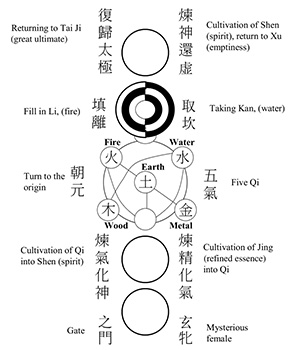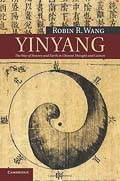start > Klassieke teksten > Late Han tot Tang > tekst
無極图 Wuji tu
wújí tú
Engelse titel: Diagram of the Non Polar ?
1. Wujitu
De Wujitu, wordt toegeschreven aan Chen Tuan. Dit diagram ligt aan de basis van de Taijitu. 1
De Wujitu was bedoeld om de voortgang van de Daoïstische praktijk van neidan 內丹 (innerlijke alchemie) te beschrijven. De Wujitu bestaat uit exact dezelfde vijf afbeeldingen als de Taijitu, maar de diagrammen verschillen op twee cruciale manieren.
Ten eerste zijn alle inscripties in de Wujitu anders.
Ten tweede moet de Wujitu van onder naar boven worden gelezen, de tegenovergestelde richting van Zhou Dunyi's Taijitu.
1.1. Het diagram
De teksten van het diagram kun je het best van onder naar boven en van rechts naar links lezen.
Je krijgt dan:
- Mysterious female - Gate
- Cultivation of Jing (refines essence) into Qi - Cultivation of Qi into Shen (spirit)
- Five Qi - Turn to the origin
- Taking Kan (water) - Fill in Li (fire)
- Cultivation of Shen (spirit), reurn to Xu (emptiness) - reurning to Tai Ji (great ultimate)
We lichten de stappen toe:
De eerste afbeelding onderaan de Wujitu stelt de poort van het mysterieuze vrouwelijke voor, het startpunt van de innerlijke alchemie.
De tweede afbeelding beschrijft een cyclische voortgang met twee continue bewegingen. Beginnend aan de rechterkant, cultiveert men jing 精 (geraffineerde essentie) tot qi 氣 (energie of vitale kracht) en verfijnt vervolgens deze qi tot shen 神 (geest).
De derde afbeelding illustreert de verbinding tussen qi en de vijf elementen en hoe ze allemaal terugkeren naar de oorsprong.
De vierde afbeelding is gevormd uit de twee I Tjing trigrammen Water (kan ☵) en Vuur (Li ☲). Deze afbeelding wordt ook wel shui huo kuang kuo tu 水火匡廓圖, het Diagram van het Kader van Water en Vuur, genoemd, dat een belangrijke rol speelt in de lichaamscultivering in de Zhouyi Can Tong Qi. De inscriptie luidt: "neem water (kan) om vuur (li) te stoppen."
De vijfde afbeelding is het hoogtepunt van deze reis, wanneer men het hoogste stadium van innerlijke alchemie heeft bereikt. 2
Chen Tuans Wujitu weerspiegelt de Daoïstische praktijk van zelfcultivatie of "innerlijke alchemie", bestaande uit drie stadia:
- het cultiveren van de verfijnde essentie om het in qi te transformeren (煉精化氣),
- het cultiveren van qi om het in geest te transformeren (煉氣化神) en
- het cultiveren van de geest om terug te keren naar leegte (煉神還虛).
De Wujitu rust leerlingen uit met een kaart waarop de cruciale punten in de voortgang worden aangegeven waarmee het lichaam en het zelf worden gecultiveerd en getransformeerd. Deze reis leidt beoefenaars terug naar het "Oneindige" of de "Leegte".
1.2. Praktijk innerlijke alchemie
In haar artikel Zhou Dunyi's Diagram of the Supreme Ultimate Explained uit 2005 volgt Robin Wang ook een tekst van Liu Zhongyu die het diagram beschrijft vanuit de praktijk van de innerlijke alchemie. De uitleg is als volgt:
- 1e afbeelding: It refers to the Elixir Field and Gate of Life in the human body, situated between the two kidneys. This is the place where the body's Original Vital Breath is stored, and in which all Inner Alchemy takes root. In the vocabulary of Inner Alchemy, it is also called 'obtaining the aperture.' "
- 2e afbeelding: Here the Original Vital Breath of the first circle is transformed and refined; Post-Existent Material Essence is transformed into Pre-Existent Vital Breath, which is once again transformed into Pre-Existent Spirit. This level of skill is called Self-Refinement, and consists mainly in making post-existent Yin substance appear as pre-existent Spirit.
- 3e afbeelding: This is called 'The Five Vital Breaths Turn to the Origin,' 'Harmonization of the Five Vital Breaths,' or simply 'Harmonization.'
- 4e afbeelding: The middle line of the Kan trigram is Yin and stands for substance; the middle line of the Li trigram is Yang and stands for emptiness. These two lines represent the interchange of the kidney's water and the heart's fire. When the Yang line of the Kan trigram is inserted into the Li trigram, one obtains the Qian trigram made up of three Yang lines, signifying the transformation of man into a pure Yang body.
- 5e afbeelding: The topmost circle is called "Refining the Spirit to Return to Emptiness," a return to the Infinite. This means that after Obtaining the Elixir, one turns back to the Infinite, which is the Great Dao of Emptiness. After accomplishing the process of inner Alchemy, one discards the Sacred Embryo which has been Refined and becomes an Immortal-this is called to "Emerge from the Womb to seek Immortality.
1.3. Relatie Laozi (Daodejing)
De Wujitu is mogelijk afgeleid van het zesde vers van de Laozi:
Voor ons is zij de ondoorgrondelijke vrouwelijkheid.
De poort van de haar vrouwelijkheid
is de wortel van hemel en aarde.
Haar wezen is als een eeuwige kringloop
met onuitputtelijke werking. (vertaling Kristofer Schipper 2010 p33)
--
The Valley Spirit does not die;
It is called the Mysterious Female.
The gateway to the Mysterious Female
Is called the root of heaven and earth.
Continious and uninterrupted, it seems to exist.
Applying thsi does not require effort (vertaling Louis Komjathy 2023 p155)
1.4. De Wujitu en en Zhou Dunyi's Taijitu
Hoewel Zhou Dunyi's Taijitu in wezen dezelfde afbeeldingen lijkt te bevatten als Chen Tuans Wujitu, leidt het lezen van boven naar beneden in plaats van van onder naar boven tot een dramatische verandering in perspectief. De Wujitu benadrukt terugkeer naar de verenigende oorsprong, terwijl Zhou Dunyi's Taijitu in plaats daarvan de beweging van de unitaire bron naar een gediversifieerde wereld benadrukt. Beide maken echter gebruik van afbeeldingen om hun standpunten over te brengen. (Wang 2012 p217-219).
2 Wu ji 無極
Todd Cameron Thacker geeft in The Encyclopedia of Confucianism de volgende uitleg van wuji, dat hij vertaalt met Non-Ultimate (zonder-uiterste):
Wu ji is een oud filosofisch concept, oorspronkelijk Daoïstisch, maar dat in het Chinese dneken verschillende scholen en toepassingen kent. Wuji is per definitie voorbij de beschrijving en overstijgt de menselijke grenzen van begrip. Het wordt gekarakteriseerd als de oorspronkelijke, vormloze bron van het universum, of in de woorden van Laozi, 'een vorm die geen vorm heeft, een beeld zonder substantie' (Daode jing 14). Voor Laozi is het de eenvoudige staat van het universum, terwijl het voor Zhuangzi zijn oneindige staat is. Wuji werd geïntroduceerd in de Confuciaanse filosofie doordat het zich vermengde met daoïstische opvattingen. In Zhou Dunyi's Taijitu shuo wordt gezegd dat de 'Great Ultimate' (Taiji) voortkomt uit Non-Ultimate (Wuji), maar dit is in strijd met de overheersende 'Zijnde' (you) in het Confucianistische denken, in tegenstelling tot het 'Niet-Zijnde' (wu) dat het fundament van het Daoïsme is. Dit leidde tot verschillende debatten over het onderwerp aangewakkerd door onder andere Zhu Xi. (Todd Cameron Thacker Wuji in Yao Xinzhong 2003 The Encyclopedia of Confucianism- 2-volume set)
Kristofer Schipper, representant van het Daoïsme, geeft de volgende uitleg van het begrip wuji:
Hoofdstuk 3.1 van Huainanzi beschrijft een kosmogonie. Die gaat in de vertaling van Komjathy als volgt:
Komjathy stelt dat in de latere Daoistische traditie deze kosmogonie wordt aangeduid met de term Wuji. Wuji vertaalt hij met non-differentiation waarbij ji (letterlijk "ridgepole") staat voor de yin-yang interactie.(Komjathy 2023 p314).
2.1. Wuji in andere klassiek daoïstische teksten
De term kom één keer voor in de Laozi, namelijk in vers 28 :
"De eeuwige innerlijke kracht zul je nooit ontberen,
en je keert terug tot het 'zonder uiterste' (wuji) "(Schipper)
"Becoming the model for the world, constant inner power will not waiver.
You will return to a condition of nondifferentiation (wuji)" (Komjathy 2023 p199)
"And with your potency (de) not wanting,
You return to the state of limitless (wuji)" (Ames & Hall 2003)
Louis Komjathy stelt dat je in de Daodejing wuji kunt vertalen met non-differentiation en ook met limitlessness. Het heeft parallellen met andere meditatieve technische termen zoals wuwu ('nothingness'), wuyou ('nonbeing'), xu ('emptiness') etc.
Vers 28 van de Laozi gaat over meditatie. Komjathy geeft de volgende parafrase van het vers:
By attending to three aspects of apophatic meditation, one becomes aligned and infused with the Dao's numinous presence. This involves cultivating receptivity, obscurity, and diminishment.
These "three guardings" (sanshou 三守) may be clarified by considering streambeds, patterns, and valleys as models. Such models reveal containment, connection, and lowliness. By actualizing such qualities, one increases inner power and returns to more integrated stats, corresponding to infancy, non-differentiation (wuji), and simplicity. Then one may retrace the movement from primordial oneness to manifestation. In a communal context, one may become an elder who guides others. This is the highest level of "governing" or "order". (Komjathy 2023 p375-376)
Wuji komt ook nog in andere klassieke daoïstische teksten voor:
Nei ye 4,
-Sommers 1.2 r16: Onbegrensd! Zoals iets dat nergens een einde heeft (Sommers p52)
- Roth IV r3: Indiscernable! as though beyond the limitless (Roth p52)
Zhuangzi hst 2,6,11,15
Huainanzi hst 1, 7, 20 en 21.
Noten
1e afbeelding: It refers to the Elixir Field and Gate of Life in the human body, situated between the two kidneys. This is the place where the body's Original Vital Breath is stored, and in which all Inner Alchemy takes root. In the vocabulary of Inner Alchemy, it is also called 'obtaining the aperture.' "
2e afbeelding: Here the Original Vital Breath of the first circle is transformed and refined; Post-Existent Material Essence is transformed into Pre-Existent Vital Breath, which is once again transformed into Pre-Existent Spirit. This level of skill is called Self-Refinement, and consists mainly in making post-existent Yin substance appear as pre-existent Spirit.
3e afbeelding: This is called 'The Five Vital Breaths Turn to the Origin,' 'Harmonization of the Five Vital Breaths,' or simply 'Harmonization.'
4e afbeelding: The middle line of the Kan trigram is Yin and stands for substance; the middle line of the Li trigram is Yang and stands for emptiness. These two lines represent the interchange of the kidney's water and the heart's fire. When the Yang line of the Kan trigram is inserted into the Li trigram, one obtains the Qian trigram made up of three Yang lines, signifying the transformation of man into a pure Yang body.
5e afbeelding: The topmost circle is called "Refining the Spirit to Return to Emptiness," a return to the Infinite. This means that after Obtaining the Elixir, one turns back to the Infinite, which is the Great Dao of Emptiness. After accomplishing the process of inner Alchemy, one discards the Sacred Embryo which has been Refined and becomes an Immortal-this is called to "Emerge from the Womb to seek Immortality.
Literatuur en vertalingen
Hieronder kunt u een selectie maken van de verschillende publicatievormen en de taal. Ik beperk me tot vier taalgebieden (Nederlands, Engels, Frans en Duits). De meeste literatuur is overigens engelstalig. U kunt bij teksttype ook apart de vertalingen selecteren en U kunt desgewenst ook een specifieke auteur zoeken.
Boeken 1 tot 3 van de 3

Patt-Shamir, Galia (2020). Reading Taijitu Shuo Synchronously: The Human Sense of Wuji er Taiji. Dao, Vol. 19, pag. 427-442. *.
Meer informatie...
Wang, Robin R. (2012). Yinyang: The Way of Heaven and Earth in Chinese Thought and Culture. *
ISBN13: 978-0521165136
Ook online.
Meer informatie...

Boeken 1 tot 3 van de 3


